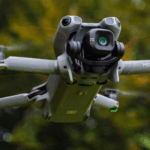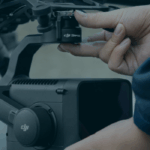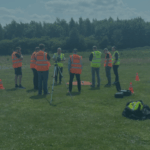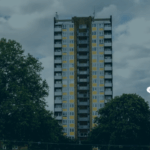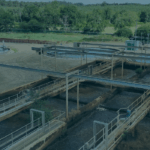Introduction
At Iprosurv, we understand that regulatory updates can often feel buried in complex jargon and technical language — but their impact on day-to-day drone operations is very real. As one of the UK’s leading drone inspection and data service providers, operating a nationwide network of over 150 professional pilots, we see firsthand how these changes affect commercial operators across multiple sectors — from construction and insurance to infrastructure and agriculture.
This guide has been written to cut through the complexity and explain, in plain English, what the upcoming 2026–2028 drone regulation changes actually mean for you as a pilot or business. Whether you’re flying a trusted legacy aircraft like a DJI Phantom 4 series, Mavic 2, or Mini 2 /3 or considering the move to the latest class-marked systems, Iprosurv is here to help you understand what’s changing, how it impacts your operations, and what steps you can take now to stay compliant, capable, and competitive.
Why the Regulations Are Changing
The UK Civil Aviation Authority (CAA) is introducing new drone regulations from 1 January 2026, including a UK class marking system (UK0–UK6) and Remote ID requirements. These updates align with international safety standards and ensure that drones can operate safely alongside manned aircraft in increasingly busy skies. The goal is to enhance airspace accountability, traceability, and operational clarity, supporting continued industry growth while maintaining public confidence.
Overview of the Changes
UK Class Marking
From 2026, all new drones sold in the UK must carry a UK class mark confirming that they meet specific safety and technical standards, such as low-speed flight modes, geo-awareness, and integrated Remote ID.
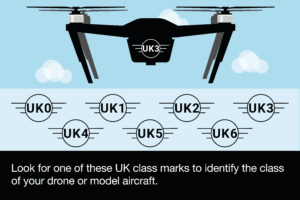
Remote ID
What Is Remote ID for Drones?
Remote ID is like a digital number plate for drones. It allows a drone to automatically broadcast its identification, location, altitude, and operator information while in flight. This data can be received by authorities or authorised parties to identify who is flying and where, helping to improve safety, accountability, and airspace management.
In the UK, Remote ID becomes mandatory from 1 January 2026 for all class-marked drones (UK1–UK6) and will extend to all drones over 100 grams with a camera by 2028. Most new drones will have built-in Remote ID capability, while older “legacy” models may require an external module or transmitter to comply.
At the same time, Remote ID will become mandatory for class-marked drones and, by 2028, for all drones over 100 grams equipped with a camera. Operators will also see changes in registration thresholds — both Flyer ID and Operator ID will be required for drones from 100 grams upward (previously 250g). While these changes enhance safety and accountability, they also mean that older, non-class-marked “legacy drones” will face increased restrictions.
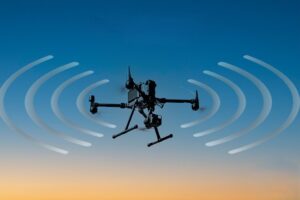
Impact on Building Inspection Operators Using Legacy Drones
For many in the inspection field, drones such as the DJI Mavic 2 series and Phantom 4 series have long served as dependable platforms … offering dependable image quality, flight stability, and easy deployment.
However, under the upcoming UK regulatory framework, these aircraft will increasingly fall under the legacy drone classification, meaning they will not benefit from the reduced safety distances and operational privileges available to new class-marked drones.
From 1 January 2026, drones such as the Mavic 2 series and Phantom 4 series can still be flown legally but will primarily fall within the Open Category A3, unless operated under an A2 Certificate of Competency (A2 CofC). Even with the A2 CofC, pilots must maintain 50 metres horizontal separation from uninvolved persons and cannot fly directly over them.
For building inspection operators, this creates a clear challenge — these distance requirements effectively prevent close façade, roof, and confined-structure surveys that the Mavic 2 and Phantom 4 once excelled at.
For operators flying the legacy drones the leap to the new C2 class of inspection drones such as the Matrice 4 series will be serious upgrade as the technology and capabilities from the old legacy drones is umastakable with advanced features such as Huge zoom capabilities, advanced mapping programmes built in, AI features such as people, vehicle and boat detection, night time cameras and many other features including in some models AI mapping features. These changes could be seen as an opportunity for operators to upskill and offer clients a whole new level of service offerings.
From 1 January 2028, all drones over 100 grams with a camera must broadcast Remote ID information during flight. Drones such as the Mavic 2 and Phantom 4 do not have built-in Remote ID functionality, meaning operators will need to purchase and attach third-party broadcast modules or external transmitters. These add-ons may increase aircraft weight, reduce flight time, and create firmware compatibility issues, making legacy drones less practical for commercial use and economically inefficient for ongoing professional inspections.
Legacy Drone Operational Rules
| Drone Type | Permitted Category | Operational Requirements | Pilot Qualification |
| Under 250g | Open A1 | May fly over people but not assemblies; minimal restrictions. | Flyer ID recommended if camera-equipped. |
| 250g–2kg | Open A2 | Maintain 50m separation from people; no overhead flight; VLOS required. | A2 CofC required. |
| Over 2kg–25kg | Open A3 | 150m from built-up areas; 50m from people; suitable for rural use. | Flyer and Operator ID required. |
Operators holding an A2 Certificate of Competency (A2 CofC) can continue flying legacy drones under 2kg indefinitely under Open A2 rules, maintaining a 50m separation from uninvolved people. However, to benefit from reduced separation distances (30m or 5m), a UK2-class drone will be required.
The Case for Transitioning to UK2-Class Drones
The new UK2-class marking (under 4kg) represents the future standard for professional inspection, survey, and infrastructure work. Examples such as the Mavic 4 Enterprise series — all engineered with built-in Remote ID, geo-awareness, and low-speed operation modes. These drones allow operations as close as 30 metres, or 5 metres in low-speed mode with an A2 CofC, ensuring compliance while maintaining flexibility for inspection work in built-up areas.
For operators currently flying legacy drones, transitioning to the new UK2/C2-class inspection platforms, such as the DJI Matrice 4 series, represents a significant step forward in capability and performance. The leap in technology is unmistakable — offering powerful zoom optics, integrated advanced mapping tools, and AI-driven features such as object, vehicle, and vessel recognition, along with night-time imaging and automated mission planning. These enhancements don’t just replace older systems; they redefine what’s possible. For professional pilots, this shift presents a real opportunity to upskill, diversify, and deliver clients an entirely new level of precision, safety, and intelligence in every inspection.
How These Changes Affect Operators
For most professionals, the new rules mean planning ahead. Legacy drones remain legal but are limited to A3 or A2 operations with significant distance constraints. Retrofits will be required for Remote ID compliance by 2028. New class-marked drones provide closer, safer operational flexibility within the Open Category, while the A2 CofC continues to be the key qualification for close operations.
Key Dates and Transition Period (2025–2028)
| Date | Change |
| Now–31 Dec 2025 | Current rules apply; no class marks required; Remote ID not yet mandatory. |
| 1 Jan 2026 | UK class marking begins; Remote ID required for UK1–UK6 drones; 100g registration threshold introduced. |
| 2026–2027 | Transition period for EU C-class recognition and Remote ID adaptation. |
| 1 Jan 2028 | Full Remote ID implementation for all drones >100g with cameras. |
Preparing for Transition
- Audit your fleet — identify which drones are legacy and plan for upgrades.
- Maintain your A2 CofC — it remains essential for A2 operations.
- Adopt class-marked drones for continued close-structure inspection work.
- Enable Remote ID on class-marked drones on 1st January 2026, and on all legacy drones ahead of the 2028 deadline.
- Stay informed through CAA updates and manufacturer certification announcements.
How Iprosurv Can Support Your Transition
As the UK drone industry evolves, Iprosurv is here to help you stay compliant, competitive, and confident. Whether it’s upskilling your team with CAA-approved training, upgrading to cutting-edge aircraft like the new DJI Mavic 4 series, or financing your move to class-marked equipment, we’re ready to support you at every stage.
Through October 2025, Iprosurv is offering up to 10% off all enterprise drones, each accompanied by exclusive free gifts such as Hoodman landing pads and discounted training packages — giving you everything you need to stay ahead as regulations change.
Our mission is simple: to keep your business airworthy, adaptable, and future-ready as the industry moves into its next phase.
📞 Call us today on 0114 4055 007
📧 Email: info@iprosurv.com
Let’s make your transition into 2026 smooth, strategic, and successful.


